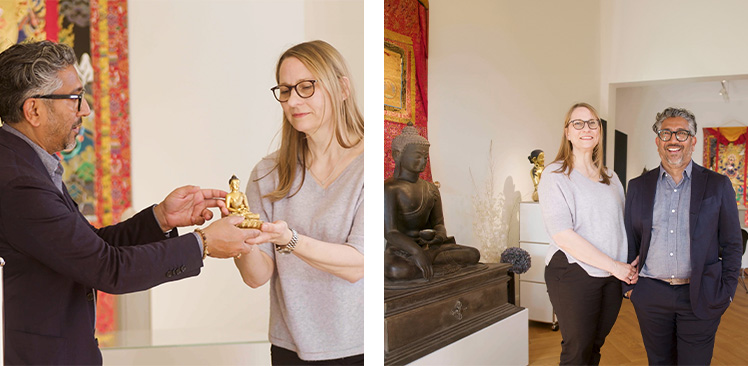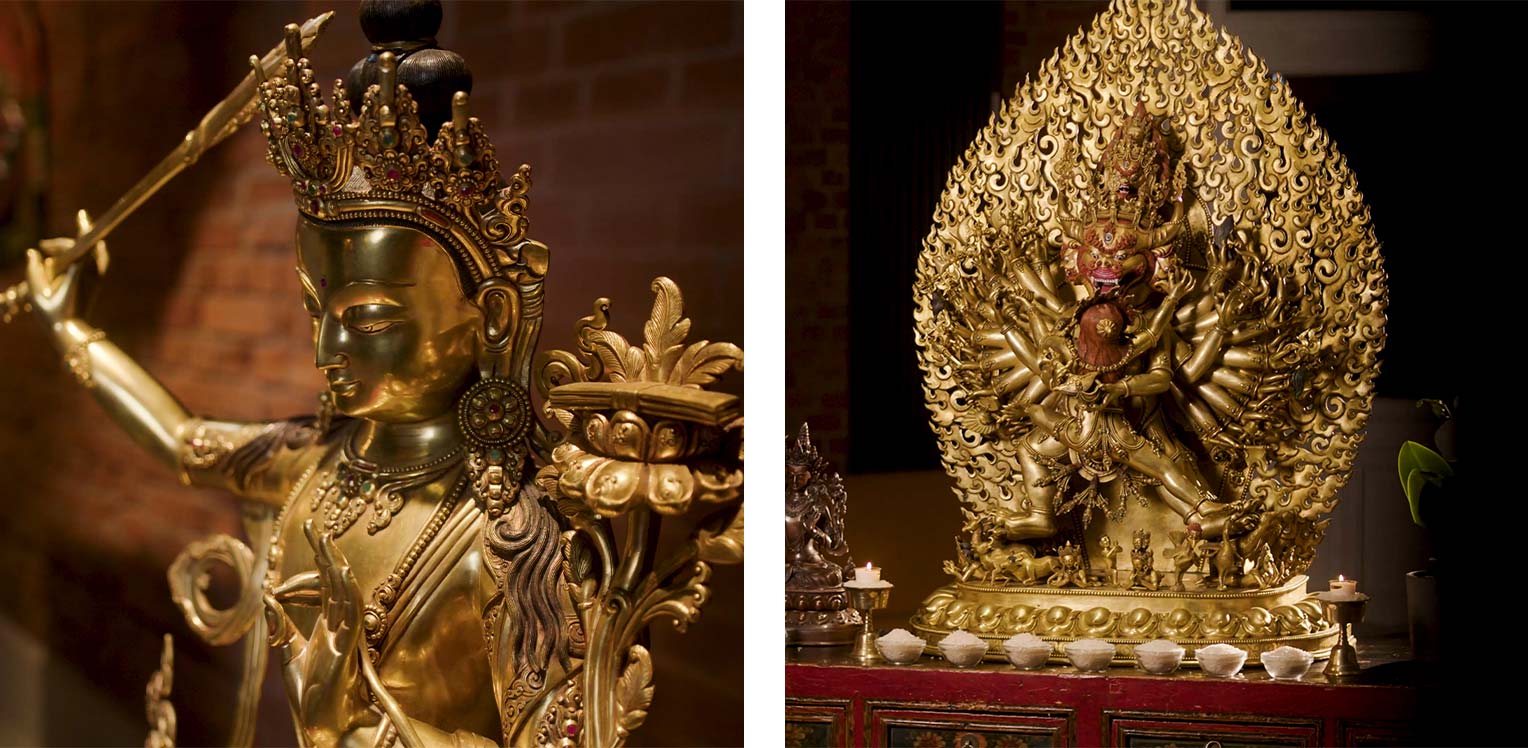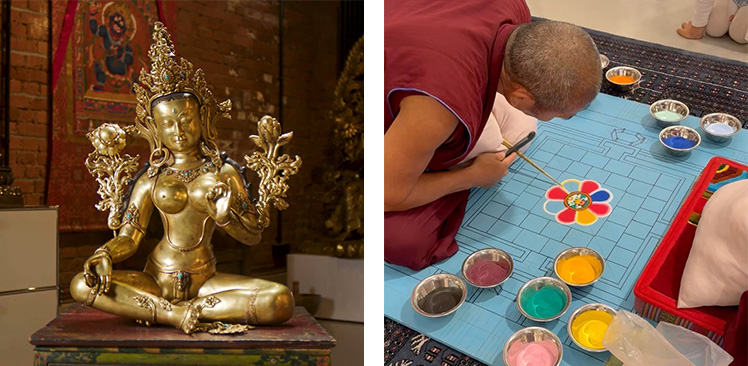Through their work, they preserve a cultural heritage deeply rooted in spiritual tradition. With a keen sense for blending tradition and modernity, Tibetan Lama Art resonates with both practicing Buddhists and art enthusiasts alike.
MANOJ RAUNIAR: A CHILDHOOD SURROUNDED BY SACRED ART
Manoj Rauniar was born in Kathmandu, a place where sacred art is deeply woven into everyday life. "In Kathmandu, sacred art is truly everywhere," he recalls. At just 15, he joined his family’s thangka business, which had close ties to the artist families of the Kathmandu Valley. His fascination with the meaning behind these works led him to Buddhist teachers in the monasteries of the region. "Our customers appreciated that I didn’t just show them the works but also explained their deeper symbolism. That connection between art and knowledge has always been important to me."
His journey later took him far beyond Nepal. "I seized every opportunity to travel. Europe especially captivated me, and I formed many friendships that ultimately inspired me to bring my vision to the world." That vision took shape in 1998 when Manoj met Nicole, a former costume designer from Germany who shared his love for art and Buddhism.
FROM HAMBURG TO ZURICH
Together, Manoj and Nicole opened their first gallery in Hamburg in 1999, followed by another in Zurich. Their motivation extends beyond preserving an artistic tradition – it’s about fostering cultural exchange and creating connections. Nicole explains: "These works of art are not just objects; they are bridges between cultures. I find it fascinating how deeply they can touch people, regardless of whether they are familiar with Buddhism or not." This philosophy is reflected in every detail. The statues are created using the lost-wax casting method, one of the oldest techniques for metal casting. Thangkas – handpainted scrolls – are crafted with pigments made from ground stones and gold leaf, finished with a singlehair brush. "The precision and dedication that go into these works are unparalleled," says Manoj. "Every piece has a soul."

AN ENCOUNTER WITH IMPERMANENCE: TIBETAN MONKS IN ZURICH
This summer, the Zurich gallery hosted a unique ritual: a group of Tibetan monks from the Sera Mey Monastery created a sand mandala. With incredible patience and concentration, the monks spent days constructing a complex, colorful pattern symbolizing the harmony of the universe. "The mandala wasn’t just a visual masterpiece," Nicole recounts. "It carried a tangible spiritual energy. You could feel the calm and focus of the monks."
Yet, the magic of a mandala lies in its impermanence. Once completed, it was dissolved in a moving ceremony. The sand, carefully placed over days, was distributed to the public and eventually scattered into a river – a ritual meant to spread positive energy and blessings into the world. "It was a powerful moment," Manoj recalls. "It reminded us all that beauty lives in the moment and that nothing is permanent."
The artworks at Tibetan Lama Art are far more than decorative objects. They serve as spiritual companions, tools for meditation, or expressions of compassion and wisdom. They attract people from all walks of life: practicing Buddhists seeking spiritual meaning, art collectors captivated by the craftsmanship, and even casual visitors drawn to a particular piece.
"Sometimes, all it takes is one look," says Manoj. "When a customer feels a deep connection to a work, I know it’s the right piece for them."
"We want our customers to understand the stories, symbolism, and significance behind the pieces," Nicole explains. Their passion is evident: "It’s always special to see how art moves people," she adds.

A significant chapter in the gallery’s history began in 2007, when Manoj and Nicole had the opportunity to assist the Dalai Lama at a major event in Hamburg.
The invitation came from an organizer who had chosen thangkas from their gallery for the stage decorations. The collaboration quickly grew beyond this. Nicole, drawing on her experience as a theater costume designer, took full responsibility for the stage design and event spaces. "It was a monumental task," she recalls, "but working with a team of friends and former colleagues was incredibly fulfilling."
During the event, Manoj and Nicole experienced the Dalai Lama not just on stage but also in quieter backstage moments. "His presence is hard to describe," Manoj says.
"There’s a depth, a calmness that fills the room. When he briefly shook my hand, it felt like that moment conveyed more than words ever could." Nicole adds: "It was an honor to witness his humility and compassion up close. Truly inspiring."
Their connection to His Holiness remained strong over the years, with the couple repeatedly invited to assist at events across Europe. For them, it was never about recognition but about making a meaningful contribution. "It was important to us to do this work voluntarily," Nicole explains. "It just felt right to give back in this way."
A HERITAGE AT RISK
Despite their beauty and significance, Nepal’s traditional crafts face immense pressure. Many ancient techniques risk being lost as modern production methods and mass tourism dominate the markets. Manoj and Nicole see it as their mission to counteract this trend. "We work closely with artist families in Nepal to ensure these techniques are preserved," says Manoj. "Every piece of art sold also supports these artisans."

A SPACE FOR EXCHANGE AND INSPIRATION
Tibetan Lama Art serves as both a cultural and spiritual meeting place. Whether through the intricate statues and thangkas, the profound sand mandalas, or Manoj and Nicole’s own stories, visiting the gallery is always an enriching experience. "Our gallery is a space where people can pause and find inspiration," says Nicole. "We want to create an environment that conveys both beauty and depth."
Through their work, Manoj and Nicole Rauniar demonstrate that art and spirituality are timeless values that transcend cultural boundaries. In a fastpaced world, they remind us that true beauty often lies in devotion – whether in art, in the moment, or in life itself.











